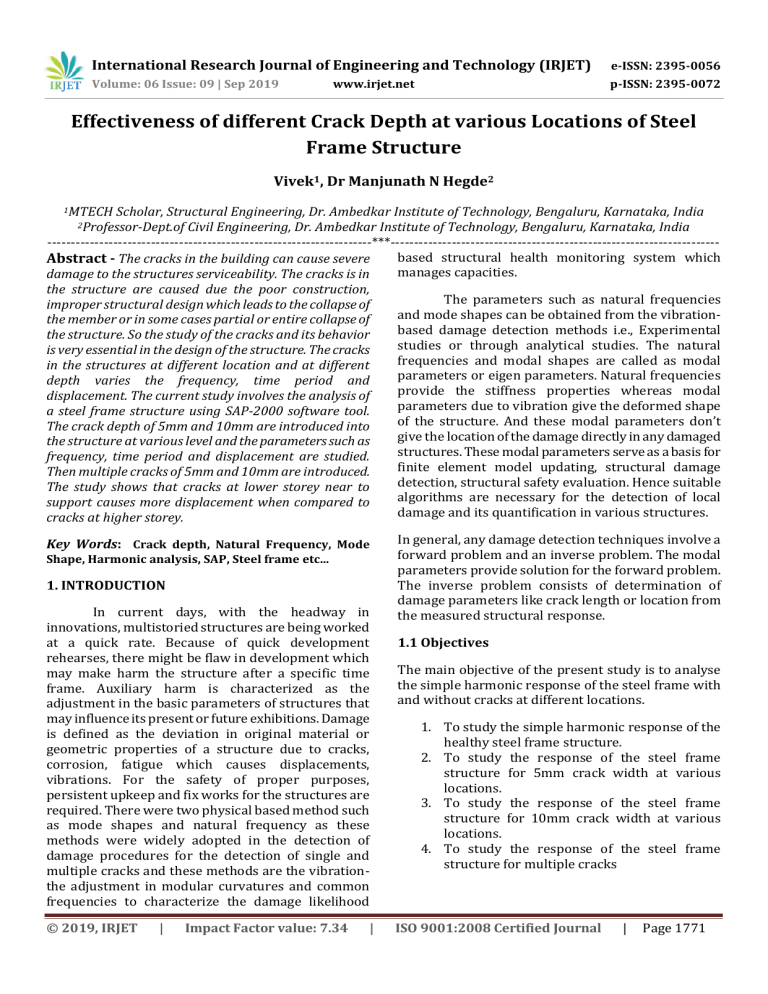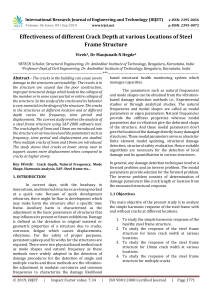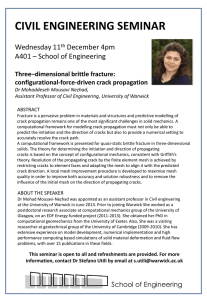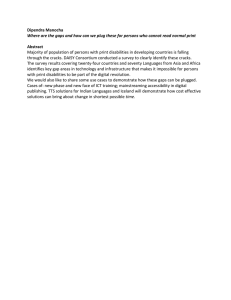Crack Depth Effect on Steel Frame Structures
advertisement

International Research Journal of Engineering and Technology (IRJET) e-ISSN: 2395-0056 Volume: 06 Issue: 09 | Sep 2019 p-ISSN: 2395-0072 www.irjet.net Effectiveness of different Crack Depth at various Locations of Steel Frame Structure Vivek1, Dr Manjunath N Hegde2 1MTECH Scholar, Structural Engineering, Dr. Ambedkar Institute of Technology, Bengaluru, Karnataka, India Civil Engineering, Dr. Ambedkar Institute of Technology, Bengaluru, Karnataka, India ---------------------------------------------------------------------***---------------------------------------------------------------------based structural health monitoring system which Abstract - The cracks in the building can cause severe manages capacities. damage to the structures serviceability. The cracks is in the structure are caused due the poor construction, The parameters such as natural frequencies improper structural design which leads to the collapse of and mode shapes can be obtained from the vibrationthe member or in some cases partial or entire collapse of based damage detection methods i.e., Experimental the structure. So the study of the cracks and its behavior studies or through analytical studies. The natural is very essential in the design of the structure. The cracks frequencies and modal shapes are called as modal in the structures at different location and at different parameters or eigen parameters. Natural frequencies depth varies the frequency, time period and provide the stiffness properties whereas modal displacement. The current study involves the analysis of parameters due to vibration give the deformed shape a steel frame structure using SAP-2000 software tool. of the structure. And these modal parameters don’t The crack depth of 5mm and 10mm are introduced into give the location of the damage directly in any damaged the structure at various level and the parameters such as structures. These modal parameters serve as a basis for frequency, time period and displacement are studied. finite element model updating, structural damage Then multiple cracks of 5mm and 10mm are introduced. detection, structural safety evaluation. Hence suitable The study shows that cracks at lower storey near to algorithms are necessary for the detection of local support causes more displacement when compared to damage and its quantification in various structures. cracks at higher storey. 2Professor-Dept.of Key Words: Crack depth, Natural Frequency, Mode Shape, Harmonic analysis, SAP, Steel frame etc... 1. INTRODUCTION In current days, with the headway in innovations, multistoried structures are being worked at a quick rate. Because of quick development rehearses, there might be flaw in development which may make harm the structure after a specific time frame. Auxiliary harm is characterized as the adjustment in the basic parameters of structures that may influence its present or future exhibitions. Damage is defined as the deviation in original material or geometric properties of a structure due to cracks, corrosion, fatigue which causes displacements, vibrations. For the safety of proper purposes, persistent upkeep and fix works for the structures are required. There were two physical based method such as mode shapes and natural frequency as these methods were widely adopted in the detection of damage procedures for the detection of single and multiple cracks and these methods are the vibrationthe adjustment in modular curvatures and common frequencies to characterize the damage likelihood © 2019, IRJET | Impact Factor value: 7.34 | In general, any damage detection techniques involve a forward problem and an inverse problem. The modal parameters provide solution for the forward problem. The inverse problem consists of determination of damage parameters like crack length or location from the measured structural response. 1.1 Objectives The main objective of the present study is to analyse the simple harmonic response of the steel frame with and without cracks at different locations. 1. To study the simple harmonic response of the healthy steel frame structure. 2. To study the response of the steel frame structure for 5mm crack width at various locations. 3. To study the response of the steel frame structure for 10mm crack width at various locations. 4. To study the response of the steel frame structure for multiple cracks ISO 9001:2008 Certified Journal | Page 1771 International Research Journal of Engineering and Technology (IRJET) e-ISSN: 2395-0056 Volume: 06 Issue: 09 | Sep 2019 p-ISSN: 2395-0072 www.irjet.net 1.2 Methodology - For Un-damped system............. (2) Simple harmonic analysis is carried out on a healthy steel frame and a frame with cracks at different locations and depths and for multiple cracks using SAP2019 software. From modal analysis first three i.e., 1st, 2nd, 3rd natural frequencies and mode shapes are obtained. = 0 – Free vibration...................................... (3) Harmonic Analysis If load is harmonic the response is also harmonic ....................................................................... (4) Table-1: Properties of the steel frame Where, Steel Frame Length of the frame Width of the frame Total height of the frame No. of bays Steel section Each storey height Modulus of elasticity Crack depth 3m 3m 9m ω – Excitation frequency t – Time period; K – Stiffness matrix; M – Mass matrix; Single bay 200x10mm 3m 210 GPa 5mm,10mm C = αM +βK – Damping matrix Excitation Force Corresponding response is expressed as ......................................................................... (5) 2. Modal Analysis The essential accessory in vibration analysis is modal analysis. To figure out the Eigen frequencies and mode shapes of structures and its structural element is the main purpose of the modal analysis. Natural frequencies and mode shapes of both cracked and uncracked frames by using SAP software has been obtained. ................................................ (6) ................................................... (7) Substituting equations (5), (6), (7) in (1) For harmonic analysis following steps considered are as follows: Developing the model (steel frame) and defining material properties and section properties. Meshing and assigning the boundary condition. Harmonic aid is utilized to measure outcome for displacement, natural frequency. Set harmonic analysis and analyze the model. Evaluate the outcome in the fashion of pictorial representation. For ) The progressed strength and weight matrix due to destructions are demonstrated as 2.1 Equation of motion - For Damped system.............. (1) © 2019, IRJET | Impact Factor value: 7.34 | ISO 9001:2008 Certified Journal | Page 1772 International Research Journal of Engineering and Technology (IRJET) e-ISSN: 2395-0056 Volume: 06 Issue: 09 | Sep 2019 p-ISSN: 2395-0072 www.irjet.net Where, Alternate in strength due to harm Alternate weight due to harm Unique strength matrix of size n x n Unique regular weight matrix of size n x n As a result damping matrix can be acquired as Fig -2: The comparison graph of Frequency v/s Displacement of Healthy steel frame and frame with cracks of (5,10mm) depths at location 0.5m 3.1 It has been observed that the maximum time period is for healthy frame structure of 3 mode shapes. As the crack depth increases the time period of the structure decrease. The percentage reduction for 10mm crack at 0.5m is 27.78% compared of healthy frame. Fig -1: 3D view of Healthy Steel Frame 3. Results and Discussion In the present study steel frame with, without cracks and multiple cracks are developed as shown in fig in the above chapter. Natural frequencies, mode shapes and displacement of cracked and un-cracked frames is gained by performing modal analysis using SAP2000 software. The crack locations are considered for the frame models as 0.5, 1.5, 2.3, 3.5, 4.5, 5.3, 6.5, 7.5, 8.3m from the support for steel. For these crack locations crack depth considered are 5, 10mm.The comparison for displacement v/s frequency of healthy and cracked beams at different locations graphs has been plotted below. © 2019, IRJET | Impact Factor value: 7.34 | Fig- 3: Comparative graph for Variation of Time period of un-cracked and cracked steel frame for 3 mode shapes at identical crack locations of different depths ISO 9001:2008 Certified Journal | Page 1773 International Research Journal of Engineering and Technology (IRJET) e-ISSN: 2395-0056 Volume: 06 Issue: 09 | Sep 2019 p-ISSN: 2395-0072 www.irjet.net 4. Conclusions Based on the results obtained the variations of Eigen frequency and Eigen vectors because of presence of crack on steel frame structure, following conclusions are done: Variations in natural frequencies and mode shapes are due to variation in crack specifications such as crack location and crack depth. Crack existing near to the fixed end support of the steel frame have greater increase in natural frequency and displacement than compared to crack existing away from the fixed support. With increase in depth of the crack at constant location there is slight increase in displacement, frequency and decrease in time period. With increase in number of cracks the natural frequency, displacement increases and time period decreases. 4.1 Scope of future work: Genetic Algorithms. Journal of Structural Engineering Vol.132, No.9 ISSN 07339445/2006/9-1491-1501. [6] Sophia Hassiotis and Garrett D. Jeong [1995], Identification of Stiffness Reductions Using Natural Frequencies. Journal of engineering mechanics Vol 121 No.10 ASCE ISSN 0733-9399/95/0010-11061113. [7] Sandeep Chaudhary Umesh Pendharkar and A. K. Nagpal [2007], Hybrid Procedure for Cracking and Time-Dependent Effects in Composite Frames at Service Load. Journal of Structural Engineering, Vol. 133, No. 2, February 1, 2007. ASCE, ISSN 07339445/2007/2166–175 [8] Wang Q. Nonlinear stiffness design optimization of tall reinforced concrete buildings under service loads, M. Philosophy thesis, Hong Kong Univ. of Science and Technology, Hong Kong, [2001]. [9] Elwood KJ, Eberhard MO. Effective stiffness of reinforced concrete columns, PEER report 1-5, Pacific Earthquake Engineering Research Center, Univ. of California, Berkeley, [2006]. 25 [10] S.K. DUGGAL. Earthquake-resistant design of structures, Second edition The effect of cracks can be studied by implementing cracks in beam element. The effect of multiple cracks can be studied by implementing cracks in columns and beam elements simultaneously. REFERENCES [1] [2] [3] [4] [5] Bin Xu and Xu Gong [2010], Damage Detection Of Reinforced Concrete Columns Based On Vibration Tests. Earth and Space 2010: Engineering, Science, Construction, and Operations in Challenging Environment ASCE Chuanchuan Hou and Yong Lu [2017], Identification of Cracks in Box-Section Beams with a Cracked-Beam Element Model. Journal of Structural Engineering. ASCE, ISSN 0733-9445 M. Ahmed, M. K Dad Khan and M. Wamiq [2008], Effect of concrete cracking on the lateral response of RCC buildings. ASIAN JOURNAL OF CIVIL ENGINEERING (BUILDING AND HOUSING) VOL. 9, NO. 1 (2008) Mark Aschheim and JoAnn Browning [2008], Influence of Cracking on Equivalent SDOF Estimates of RC Frame Drift. Journal of structural engineering Vol. 134. No. 3, ISSN 07339445/2008/3-511-517. Ricardo Perera and Ronald Torres [2006], Structural Damage Detection via Modal Data with © 2019, IRJET | Impact Factor value: 7.34 | ISO 9001:2008 Certified Journal | Page 1774





